How much credit for the Covid vaccines goes to government and how much to entrepreneurs? Loftus’s book focuses on Moderna, and makes the case that government deserves considerable credit, mostly for early funding. A case can be made that at least as much focus should be given to BioNTech. If BioNTech had been the focus, that case might have been harder to make.
(p. C5) In late 2019, just weeks before the world heard of Covid-19, scientists from the National Institute of Allergy and Infectious Diseases visited the new manufacturing plant of a small, 9-year-old biotechnology company called Moderna. The company’s leaders boasted that the new plant in Norwood, Mass., could make a batch of a newly designed vaccine in 60 days—rapid by standard timelines that usually take 12 months or more.
. . .
One Friday afternoon in August [2020], the company was expecting delivery of large air-handling units to help expand production at its factory. Moderna had hired construction cranes to lift the tractor-trailer-sized units onto the roof of its plant. But delivery was delayed because the supplier lacked all the state permits needed to transport oversize cargo from the Midwest to Massachusetts. If the units didn’t get there by Sunday, Moderna would lose the cranes and a week of production.
Frantic, Moderna executives called Warp Speed officials. They gave the job to an Army colonel, who leaned on state officials, who in turn sent state police with sirens blaring to escort the delivery to their state line and then hand off the convoy to a new escort. The precious cargo rolled into Moderna’s plant on Sunday morning, in time for the cranes.
The much larger and older Pfizer, meanwhile, mostly opted out of Operation Warp Speed for fear it would slow the company down. As for Moderna’s collaboration, it generated enough friction to make the company’s chief medical officer during 2020, Tal Zaks, question at times whether it was worth it to accept the federal assistance.
Dr. Zaks had wanted to use a private contract research organization to run the whole trial, but NIAID officials wanted their clinical-trial network involved. Eventually, Dr. Zaks backed off, and both entities participated. “I realized we were at an impasse, and I was the embodiment of the impasse,” Dr. Zaks said.
Next, when Moderna’s 30,000-person study began enrolling volunteers in July 2020, the subjects weren’t racially diverse enough. Moncef Slaoui, who led Warp Speed’s vaccine efforts, and Dr. Fauci began holding Saturday Zoom calls with Mr. Bancel and other Moderna leaders to “help coax and advise Moderna how to get the percentage of minorities up to a reasonable level,” Dr. Fauci recalled.
Drs. Fauci and Slaoui wanted Moderna to slow down overall enrollment, to give time to find more people of color. Moderna executives resisted at first. “That was very tense,” Dr. Slaoui said. “Voices went up, and emotions were very high.” Moderna ultimately agreed, and the effort worked, but it cost the trial about an extra three weeks. Later, Mr. Bancel called the decision to slow enrollment “one of the hardest decisions I made this year.”
For the full essay, see:
Peter Loftus. “The Partnership That Made the First U.S. Covid Vaccine.” The Wall Street Journal (Saturday, July 30, 2022): C5.
(Note: ellipsis, and bracketed year, added.)
(Note: the online version of the essay has the date July 29, 2022, and has the same title as the print version.)
The essay quoted above is an adaptation from Loftus’s book:
Loftus, Peter. The Messenger: Moderna, the Vaccine, and the Business Gamble That Changed the World. Boston: Harvard Business Review Press, 2022.


